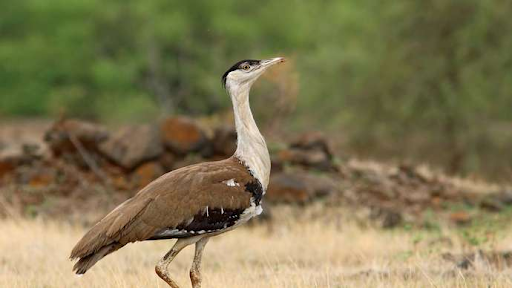Great Indian Bustard
About GIB
- Great Indian Bustard (GIB) is one of the heaviest flying birds endemic to the Indian subcontinent.
- Protection Status: I
- UCN Red List: Critically Endangered; CITES: Appendix I; Wildlife Protection Act (1972): Schedule I.
- Historically, the great Indian bustard was distributed throughout Western India, spanning 11 states, as well as parts of Pakistan. Today, its population is confined mostly to Rajasthan and Gujarat. Small populations occur in Maharashtra, Karnataka and Andhra Pradesh.
Conservation Issues
- The biggest threat to this species is hunting, which is still prevalent in Pakistan. This is followed by occasional poaching outside Protected Areas, collisions with high tension electric wires, fast moving vehicles and free-ranging dogs in villages.
- Other threats include habitat loss and alteration as a result of widespread agricultural expansion and mechanized farming, infrastructural development such as irrigation, roads, electric poles, as well as mining and industrialization.
Conservation strategies
- The only opportunity to potentially recover this species remains in the Thar landscape of Rajasthan, where the birds are now limited to two extant populations – one inside Desert (National Park) Sanctuary near Jaisalmer, and the second population located in the grasslands and agricultural lands of Pokhran and Ramdeora.
- The Great Indian Bustard has also been identified as one of the species for the recovery programme for critically endangered species of the Ministry of Environment, Forest and Climate Change (MoEFCC).

Why in News?
- The Supreme Court has directed the Rajasthan and Gujarat governments to file their status reports on converting overhead electric cables into underground power lines, wherever feasible, within a year to protect the endangered Great Indian Bustard from extinction.
- In April last year, the top court, in a bid to save the GIB, directed the Gujarat and Rajasthan governments to convert overhead electric cables into underground power cables, wherever feasible, within a year to prevent death of the birds due to collision and electrocution.
Related Information
Recovery programme for critically endangered species
-
- The programme is a component of the centrally funded scheme, Integrated Development of Wildlife Habitats (IDWH).
- Started in 2008-09, IDWH is meant for providing support to protected areas (national parks, wildlife sanctuaries, conservation reserves and community reserves except tiger reserves), protection of wildlife outside protected areas and recovery programmes for saving critically endangered species and habitats.
- The recovery programme includes more than 20 wildlife species.
- It includes Snow Leopard, Bustard, Dolphin, caracal, Hangul, Nilgiri Tahr, Marine Turtles, Dugongs, Edible Nest Swiftlet, Asian Wild Buffalo, Nicobar Megapode, Manipur Brow-antlered Deer, Vultures, Malabar Civet, Indian Rhinoceros, Asiatic Lion, Swamp Deer, Jerdon’s Courser, the Northern River Terrapin, Clouded Leopard, Arabian Sea Humpback Whale and Red Panda.
Reference:
Subscribe
Login
0 Comments
